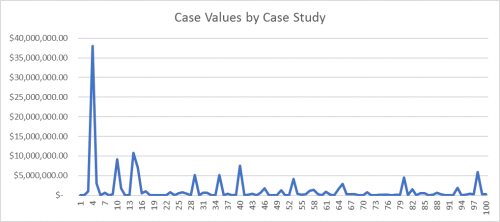From a 100 case sample of loss of sight cases, taken from jury verdict research across the State of Florida, we saw five high-value outliers of $7 million dollars, $7.5 million dollars, $9.2 million dollars, $10.8 million dollars, and $38 million dollars. After studying the distribution of case values in this sample and considering the average case value, we determined that any value of over $6 million dollars would be included as an outlier in the analysis of this sample. However, the large range of typical values made it difficult to make a clear distinction between outlying cases and non-outlying cases. When looking at Figure 1, you can see the outliers’ deviation from the normal trend of values in the sample. Figure 2 shows the data without the $38 million-dollar outlier which clarifies the lack of real “trend” in the data.

Figure 1. This line graph shows the trend of case values in the sample including the $38 million-dollar outlier.

Figure 2. This line graph shows the trend of case values in the sample excluding the $38 million-dollar outlier.
Outliers are values that show themselves as far above (or below) the calculated average of any data set. Outliers direct a researcher to look at a specific data point to determine why that point would stray from the regular trend of values in that set. In jury verdict research, outliers point anyone analyzing jury verdicts to a specific case to analyze the facts of that case and determine why that case received a higher verdict or settlement in a jury trial setting than another similar case. High-value outliers must be studied in terms of their ability to skew the average of a data set from their high value. Because outliers cause the average case value of a sample to change, it’s important to always calculate averages with and without the outliers for the most representative average of a data set.
Outlying cases generally have intrinsic differences from the other cases in the sample that set them apart from the overall trend of the other cases in the sample. To exemplify this, let’s look at some of the outliers from the sample, starting with the highest-valued case.
In Case Study 3, we saw premature twin newborn boys who were both affected by full and permanent blindness in both eyes. The defendant was the ophthalmologist involved in the care of the boys. The plaintiffs, the parents of the boys, claimed that the defendant ophthalmologist negligently failed to diagnose retinopathy of prematurity (“ROP”), resulting in the boys’ condition. The defendants maintained that the condition was diagnosed and treated as soon as possible. Both boys were susceptible to ROP, which affects the blood vessels supporting the retina that can become detached if not treated. When the defendant examined twin A shortly after birth, he didn’t find any signs of ROP. Twin B, however, was diagnosed with Stage I ROP. A follow-up exam showed no ROP in either twin, and the defendant diagnosed Twin B with a vitreous hemorrhage and referred him to a surgeon. The nonparty surgeon diagnosed Stage IV ROP in both of Twin B’s eyes, leaving him blind in both eyes. The plaintiffs’ expert claimed that the ROP would have been evident at the time of the defendant’s exam 19 days prior. Twin A was diagnosed with ROP on the same day as Twin B and is also blind in both eyes. The plaintiff’s medical experts claimed that early intervention could have saved the boys’ sight. The defendant claimed that he closely monitored the twins and examined Twin A 4 times and Twin B 3 times in their first 3 months of life. He also contended that no signs of ROP were seen until diagnoses and that in 90% of cases of ROP, the condition resolves on its own. The parents of the boys were given $5 million dollars in loss of services and the total award was $38 million dollars.
Case Study 39 involved a 24-year-old male plaintiff and a products liability case where the plaintiff was totally blinded and disfigured when a boat cleat pulled loose and struck the plaintiff between the eyes. He alleged that the cleat was defectively designed because it was attached with only wood screws and that the defendant failed to test the cleat or warn of its possible dangers. The defendant contended that the boat hadn’t been properly maintained and that the accident was caused by the rotten wood underneath. This case was resolved with a plaintiff’s verdict and an award of $7.5 million dollars.
Finally, Case Study 14 showed a 44-year-old male plaintiff who suffered a hypoxic injury, resulting in cortical blindness, when he was underventilated at the defendant hospital after surgery. When his carbon dioxide level rose, he was placed on an outdated ventilator. From this, he lost his sight fully in both eyes. This case was resolved in a settlement where the codefendant anesthesia associates contributed $3 million dollars and the defendant hospital contributed $7.8 million dollars to bring the total award amount to $10.8 million dollars.
To learn more about the value attributed to all loss of sight cases, please click here.
If you’re a potential client, or an attorney seeking a second opinion, and would like to discuss the value of your case please feel free to call me anytime at (850)-244-3310.





